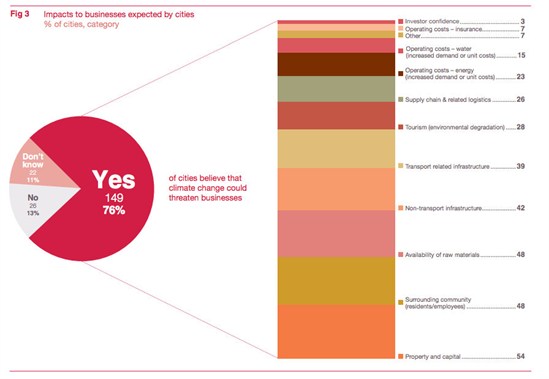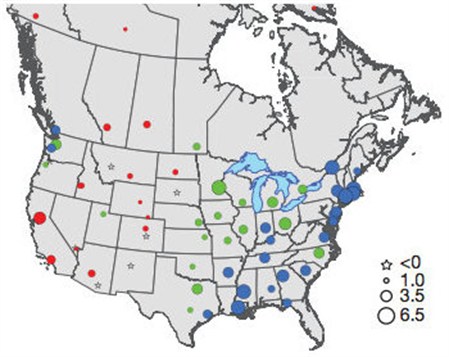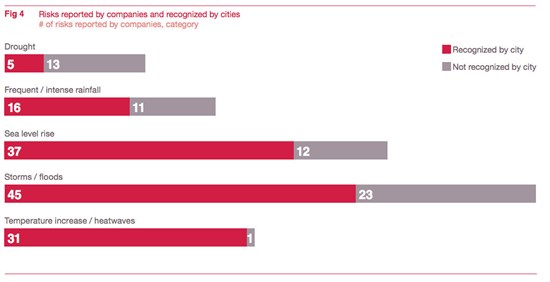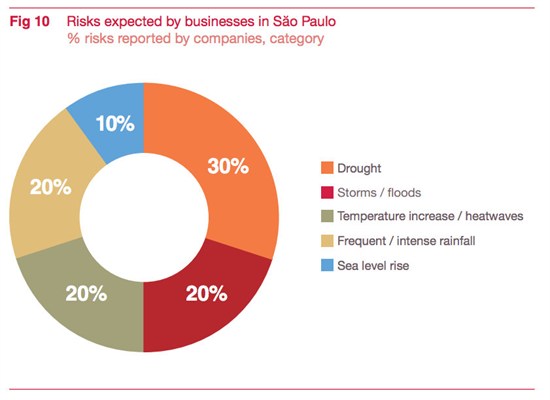
What’s your city doing to protect you from climate change? In six charts
Roz Pidcock
07.10.14Roz Pidcock
10.07.2014 | 4:45pmFrom London to Sao Paulo, half the world’s population resides in huge urban metropolises. But living in some cities will be worse for your health than others. New research pinpoints more than 200 cities leading the way in tackling climate, protecting citizens and businesses along the way.
Is yours one of them?
Cities under pressure
Cities are hubs of economic and human activity. They house at least 50 per cent of the world’s population and produce more than 80 per cent of its gross domestic product (GDP).
But the concentration of people and assets make cities vulnerable when disaster strikes. In its latest report, the Intergovernmental Panel on Climate Change (IPCC) warned of an increasing risk to cities from climate change, through rising temperatures, increasing frequency and severity of heatwaves, and greater risk of flooding. Coastal cities also have to deal with rising sea level rise.
But cities are taking the initiative in tackling climate change, according to a new report from the Cities Climate Leadership Group ( C40). It looked at what 207 cities across the world are doing to alleviate climate change’s impacts.
Waking up to climate change threats
Source: CDP Global Cities Report 2014
The concentration of people and industry means cities are responsible for per cent of global greenhouse emissions. But there’s some good news on that front.
Together, emissions reductions in Denver, London, Madrid, Durban and Taipei add up to 12 per cent compared to 2009 levels – a total saving of 13.1 million tons of carbon dioxide equivalent.
On top of mitigation efforts, cities are waking up to the risks posed by climate change. Of the 207 cities surveyed, 76 per cent recognised that climate change could impact business.
What are the risks?
The potential impacts on cities are far-ranging, affecting food supply and distribution, disruption to supply chains, transport, tourism and the health and well-being of the resident workforce.
In the 76 per cent of cities that recognised climate change risks, the most common concerns were damage to property and capital, as the figure below show. Next were impacts on residents, availability of raw materials, and infrastructure.
Source: CDP Global Cities Report 2014
Feeling the heat
Rising temperatures in cities exacerbates the Urban Heat Island (UHI) effect. This where the design and density in a city means surface temperatures are higher than the surrounding countryside.
The map below from a new paper also out yesterday looked at different cities across America, concluding the UHI effect – and its impacts of heat stress on residents – is worse in wet climates.
Cities in the wetter eastern part of the country fare rather less well than those in the west – with the UHI effect raising temperatures by more than six degrees Celsius in some places.
Source: CDP Global Cities Report 2014
Small circles mean a small UHI effect, big circles the biggest. Red dots are cities with low annual rainfall, blue dots have high annual rainfall. Green is in the middle. Source: Zhao et al., ( 2014)
Cities face other direct risks on top of temperature changes. The Organisation for Economic Cooperation (OECD) recently concluded more than $3 trillion in assets is at risk from climate change impacts on ports – which make up more than 50 per cent of the world’s largest cities.
In Cleveland in the US, the $6.5 billion shipping industry in Lake Erie is at risk from as combination of more frequent large storms and lower lake levels, says the report.
Cities taking action
Businesses are likely to be particularly vulnerable to changing climate, as the recent “Risky Business” report highlighted in the US. But perceptions of climate risk in the businesses community aren’t necessarily aligned with those of the city itself, the new report says.
But as the chart below shows, there’s fairly broad agreement – only 31 per cent of the risks identified by businesses weren’t also recognised by the city government, the report finds.
For the most serious physical risks, the figure is lower at 25 per cent. The strongest agreement between cities and businesses is in temperature related impacts, like the impact of heat stress.
Source: CDP Global Cities Report 2014
Where cities and businesses have identified the same risks, they’re taking action against them in 96 per cent of cases, the report notes.
Who’s doing what to adapt?
Cities are making significant efforts to make themselves more resilient to climate change’s impacts, says the report. In total, 102 of the 207 cities surveyed have climate adaptation plans – that’s a total of 757 separate adaptation measures.
There are a number of ways cities can increase its resilience to climate change. They can direct invest in flood management plans, emergency response systems and infrastructure. Local governments can also regulate for businesses to manage their own risks, or create incentives.
Take the city of London. As the chart below shows, the biggest risk expected by businesses is from storms and floods (red), followed by the effects of rising temperatures and sea level rise.
Source: CDP Global Cities Report 2014
Energy efficiency in London is prioritised through building design, says the report. The Greater London Authority invests $188,000 a year to support businesses to create green roofs, for example. This is intended to reduce both energy consumption and the need for air conditioning.
This makes particularly interesting reading this week as there’s been concern in the UK media that the part of government responsible for adaptation isn’t taking climate change seriously.
A new report from the Committee on Climate Change warned our roads, railways and water companies are ill-equipped to face the consequences of climate change.
A tailored approach
Other cities are taking different approaches, tailored to their own vulnerabilities. Sao Paulo is a huge megacity – the largest city by population in the southern hemisphere. As an emerging economy, climate change exacerbates the challenges the city already faces, the report notes.
Managing land use, building flood defences and better water management are key priorities. Drought is the biggest concern for businesses from climate change, as the chart below shows. The city is also investing $22 billion to improve its transport infrastructure, the report notes.
Source: CDP Global Cities Report 2014
There are co-benefits to adaptation, says the report. Future-proofing cities makes them more attractive to new business, which brings in jobs, tax revenue and services. 97 per cent of cities recognise climate change adaptation can create new economic opportunities, the report notes.
For example, Portland in the United States reports that it saves $5.5 million each year through its City Energy Challenge, which invests in energy, water and communication networks.
Business is where it all begins, is the message of the report. Beginning by embedding local adaptation measures in their own day-to-day operations will help reduce climate change risks across the city, the report concludes. What’s more, it’s often local businesses that will be the first to highlight climate change risks to society and the wider economy, which cities can follow up on.







